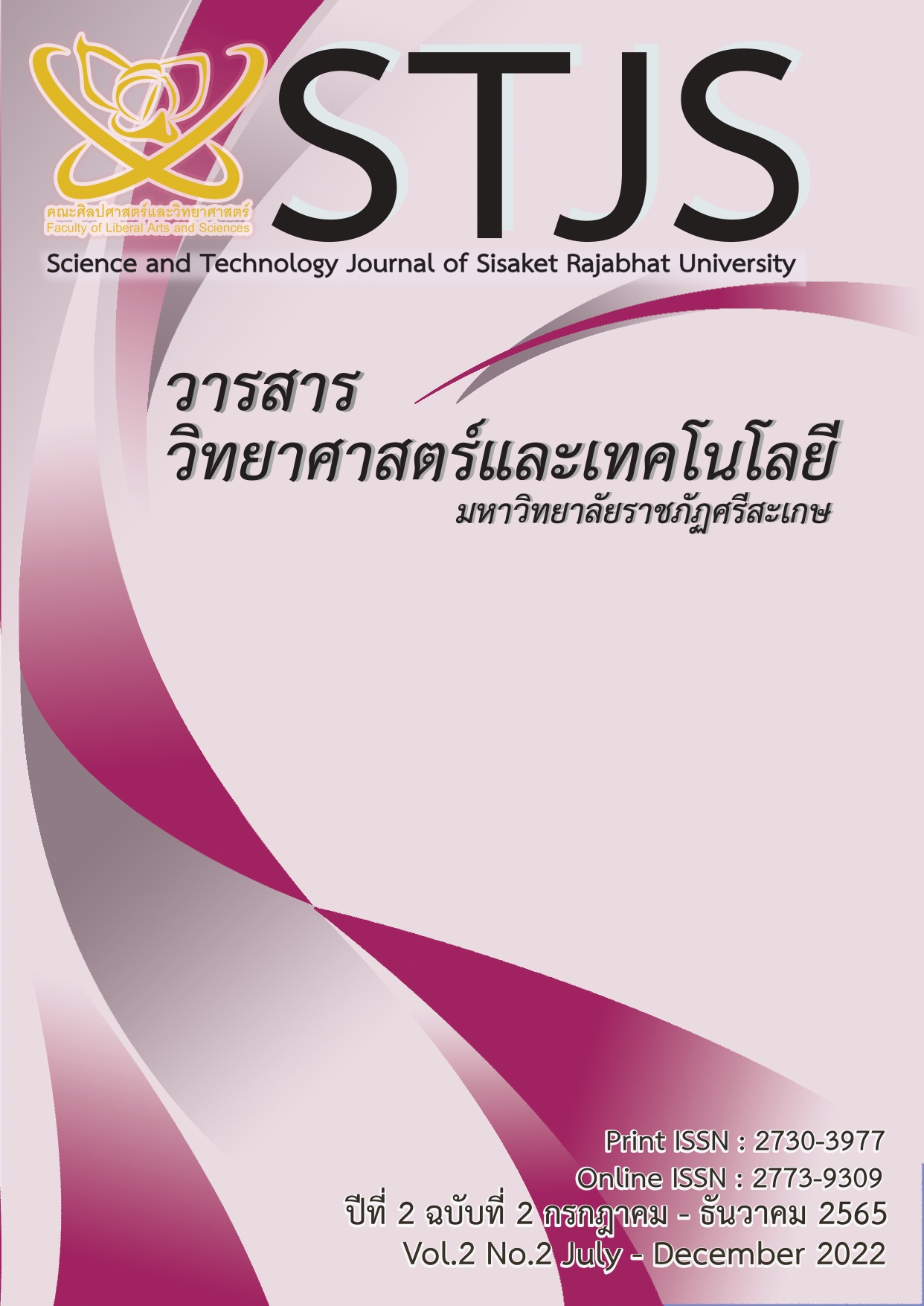ผลของสารสกัดชาเขียวต่อคุณภาพของครีมชีสสเปรด
Main Article Content
บทคัดย่อ
วัตถุประสงค์ของการศึกษานี้เพื่อประเมินความสามารถในการต้านการเกิดออกซิเดชันของสารสกัดชาเขียวและผลของการเติมสารสกัดชาเขียวที่ระดับ ร้อยละ 0.5, 1.0 และ 1.5 ต่อคุณสมบัติทางเคมีและกายภาพของครีมชีสสเปรด รวมถึงการเปลี่ยนแปลงระหว่างการเก็บรักษา สารสกัดชาเขียวมีปริมาณสารประกอบฟีนอลิกที่สูงโดยมีค่า 1,660.71 mg GAE/g dry extract และมีความสามารถในการจับอนุมูลอิสระดีพีพีเอช และการจับโลหะเหล็กที่ 67.84 mg TE/ g dry extract และ 75.16 mmol EDTA/g dry extract ตามลำดับ การเติมสารสกัดชาเขียวไม่ส่งผลต่อค่าความชื้น โปรตีน และไขมันของชีสสเปรดอย่างมีนัยสำคัญทางสถิติ (p>0.05) อย่างไรก็ตาม การเติมสารสกัดชาเขียวส่งผลต่อค่าสีของชีสสเปรดอย่างมีนัยสำคัญทางสถิติ (p£0.05) โดยทำให้เกิดการลดลงของค่าความสว่าง (L*) และการเพิ่มขึ้นของค่าสีแดง (-a*) และค่าสีเหลือง (b*) ดังนั้นจึงส่งผลให้คะแนนความชอบด้านสีและความชอบโดยรวมมีค่าลดลงเมื่อมีการเติมสารสกัดชาเขียว การเติมสารสกัดชาเขียวที่ความเข้มข้นร้อยละ 1.0 และ 1.5 อาจส่งผลให้เกิดการเพิ่มขึ้นของค่าความเป็นกรดทั้งหมดและมาโลนาลดีไฮด์ นอกจากนี้ ไม่พบการเปลี่ยนแปลงของค่าความเป็นกรดทั้งหมดและมาโลนาลดีไฮด์ในทุกตัวอย่างระหว่างการเก็บรักษาที่อุณหภูมิ 4 องศาเซลเซียส เป็นเวลา 21 วัน อย่างไรก็ตาม การเติมสารสกัดจากชาเขียวอาจช่วยเพิ่มสารต้านอนุมูลอิสระจากธรรมชาติในผลิตภัณฑ์ครีมชีสสเปรดซึ่งถือเป็นผลิตภัณฑ์ทางเลือกหนึ่งให้แก่ผู้บริโภค
Article Details

อนุญาตภายใต้เงื่อนไข Creative Commons Attribution-NonCommercial-NoDerivatives 4.0 International License.
เนื้อหาและข้อมูลในบทความที่ลงตีพิมพ์ในวารสารวิทยาศาสตร์และเทคโนโลยี มหาวิทยาลัยราชภัฏศรีสะเกษ ถือเป็นข้อคิดเห็นและความรับผิดชอบของผู้เขียนบทความโดยตรงซึ่งกองบรรณาธิการวารสาร ไม่จำเป็นต้องเห็นด้วย หรือร่วมรับผิดชอบใด ๆ
บทความ ข้อมูล เนื้อหา รูปภาพ ฯลฯ ที่ได้รับการตีพิมพ์ในวารสารวิทยาศาสตร์และเทคโนโลยี มหาวิทยาลัยราชภัฏศรีสะเกษ ถือเป็นลิขสิทธิ์ของวิทยาศาสตร์และเทคโนโลยี มหาวิทยาลัยราชภัฏศรีสะเกษ หากบุคคลหรือหน่วยงานใดต้องการนำทั้งหมดหรือส่วนหนึ่งส่วนใดไปเผยแพร่ต่อหรือเพื่อกระทำการใด จะต้องได้รับอนุญาตเป็นลายลักอักษรจากวารสารวิทยาศาสตร์และเทคโนโลยี มหาวิทยาลัยราชภัฏศรีสะเกษ ก่อนเท่านั้น
เอกสารอ้างอิง
Phadungath, C. (2005). Cream cheese products: A review. Songklanakarin Journal of Science and Technology, 27(1), 191-199.
ปิยาภัทร ไตรสนธิ. (2560). ชา: เครื่องดื่มเพื่อสุขภาพและสุนทรียภาพ. อาหารและสุขภาพ, 47(4), 12-18.
Giroux, HJ., Grandpré, GD., Fustier, P., Champagne, CP., St-Gelais, D., Lacroix, M. and Britten, M. (2013). Production and characterization of Cheddar-type cheese enriched with green tea extract. Dairy Science and Technology, 93, 241-254.
Evstigneeva, T., Skvortsova, N., and Yakovleva, R. (2016). The application of green tea extract as a source of antioxidants in the processing of dairy product. Agronomy Research, 14(S2), 1284-1298.
Rashidinejad, A., Birch, EJ. and Everett, DW. (2016). Antioxidant activity and recovery of green tea catechins in full-fat cheese following gastrointestinal stimulated digestion. Journal of Food Composition and Analysis, 48, 13-24.
Wang, R. & Zhou, W. (2004). Stability of tea catechins in the breadmaking process. Journal of Agricultural and Food Chemistry, 52, 8224-8229.
Jo, C., Son, JH., Son, CB. and Byun, MW. (2003). Functional properties of raw and cooked pork patties with added irradiated, freeze-dried green tea leaf extract powder during storage at 4C. Meat Science, 64(1), 13-17.
Yoon, J., Bae, SM., Gwak, SH. and Jeong, JY. (2021). Use of green tea extract and rosemary extract in naturally cured pork sausages with white kimchi powder. Food Science and Animals Resources, 41(5), 840-854.
Huvaere, K., Nielsen, JH., Bakman, M., Hammershj, M., Skibsted, L.H., Srensen, J., Vognsen, L. and Dalsgaard, TK. (2011). Antioxidant properties of green tea extract protect reduced fat soft cheese against oxidation induced by light exposure. Journal of Agricultural and Food Chemistry, 59, 8718-8723.
Waterhouse, AL. (2003). Determination of total phenolic compounds. Retrieved 1 May 2022, from https://currentprotocols.onlinelibrary.wiley.com/doi/abs/10.1002/0471142913.fai0101s06
Sanchez-Moreno, C., Larrauri, JA. and Saura-Calixto, F. (1998). A Procedure to measure the antiradical efficiency of polyphenols. Journal of the Science Food and Agriculture, 76, 270-276.
Dinis, TC., Maderia, VM. and Almeida, LM. (1994). Action of phenolic derivatives (acetaminophen, salicylate and 5-aminosalicylate) as inhibitors of membrane lipid peroxidation and as peroxyl radical scavengers. Archives of Biochemistry and Biophysics, 315, 161-169.
Jantapirak, S., Klongdee, S., Limsangouan, N., Kantrong, H. and Prasert, W. (2021). Effects of chitosan and phosphate on quality characteristics and shelf life extension of pork meatballs. Agriculture and Natural Resources, 55, 219-228.
AOAC: Official Methods of Analysis. (2000). 17th ed. Arlington, VA, USA.
Huang, W-Y., Lin, Y-R., Ho, R-F., Liu, H-Y. and Lin, Y-S. (2013). Effects of water solutions on extracting green tea leaves. Scientific World Journal, v.2013, 1-6.
Lamothe, S., Azimy, N., Bazinet, L., Couillard, C. and Britten, M. (2014). Interaction of green tea polyphenols with dairy matrices in a simulated gastrointestinal environment. Food & Function, 5, 2621-2631.
O'Connell, JE & Fox, PF. (2001). Significance and applications of phenolic compounds in the production and quality of milk and dairy products: a review. International Dairy Journal, 11, 103–120.
Namal Senanayake, SPJ. (2013). Green tea extract: Chemistry, antioxidant properties and food applications – A review. Journal of Functional Foods, 5(4), 1529-1541.
Graham, HN. (1992). Green tea composition, consumption, and polyphenol chemistry. Preventive Medicine, 21, 334–350.
Shahidi, F. & Zhong, Y. (2005). Lipid oxidation: measurement methods. In F. Shahidi (Ed.). Bailey’s industrial oil and fat products (pp. 357-385). New Jersey: John Wiley & Sons, Inc.
Downey, WK. (1969). Lipid oxidation as a source of off-flavour development during the storage of dairy products. International Journal of Dairy Technology, 22(3), 154-161.


